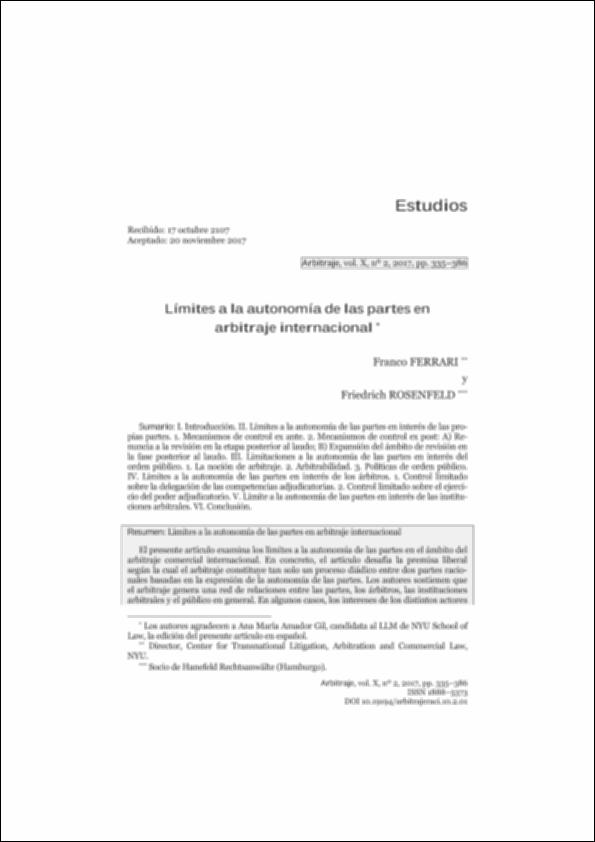Por favor, use este identificador para citar o enlazar este ítem:
http://hdl.handle.net/10637/12490Límites a la autonomía de las partes en arbitraje internacional.
| Título : | Límites a la autonomía de las partes en arbitraje internacional. |
| Autor : | Ferrari, Franco Rosenfeld, Friedrich |
| Materias: | Arbitraje comercial internacional.; Autonomía de la voluntad de las partes.; Taxonomía de las limitaciones.; International commercial arbitration.; Party autonomy.; Taxonomy of limitations. |
| Resumen : | El presente artículo examina los límites a la autonomía de las partes en el ámbito del
arbitraje comercial internacional. En concreto, el artículo desafía la premisa liberal
según la cual el arbitraje constituye tan solo un proceso diádico entre dos partes racionales
basadas en la expresión de la autonomía de las partes. Los autores sostienen que
el arbitraje genera una red de relaciones entre las partes, los árbitros, las instituciones
arbitrales y el público en general. En algunos casos, los intereses de los distintos actores solo pueden resolverse limitando la autonomía de las partes. En este contexto, los autores
desarrollan la taxonomía de las limitaciones distinguiendo según su finalidad de
proteger los intereses de las partes, de los árbitros, de las instituciones arbitrales o bien
del público en general. En opinión de los autores, una comprensión adecuada de estas
limitaciones es fundamental si se pretende proteger al arbitraje de los desafíos que
enfrenta su legitimidad y apoyar su papel como instrumento primario de resolución de
disputas comerciales. The present paper examines the limitations to party autonomy in international commercial arbitration. As such, it challenges the liberalist premise that arbitration is purely a dyadic process between two rational parties based on an expression of party autonomy. The authors submit that arbitration creates a web of relationships involving the parties, the arbitrators, arbitral institutions, and the public at large. While the interests of these different stakeholders overlap in some cases, they diverge in others, thus creating tensions that at times can only be solved by limiting party autonomy. Against this background, the authors develop a taxonomy of limitations by distinguishing between limitations to party autonomy in the interest of the parties, the arbitrators, arbitral institutions as well as the public at large. It is the authors’ position that a clear understanding of these limitations is necessary to protect arbitration against legitimacy challenges and to uphold its role as the primary instrument for the resolution of business disputes. |
| Descripción : | En: Arbitraje: revista de arbitraje comercial y de inversiones. eISSN. 2603-9281. vol. 10, n. 2, 2017, pp 335-386 |
| URI : | http://hdl.handle.net/10637/12490 |
| Derechos: | http://creativecommons.org/licenses/by-nc-nd/4.0/deed.es |
| Fecha de publicación : | 7-nov-2017 |
| Aparece en las colecciones: | 2017 Arbitraje nº 2 |
Los ítems de DSpace están protegidos por copyright, con todos los derechos reservados, a menos que se indique lo contrario.


